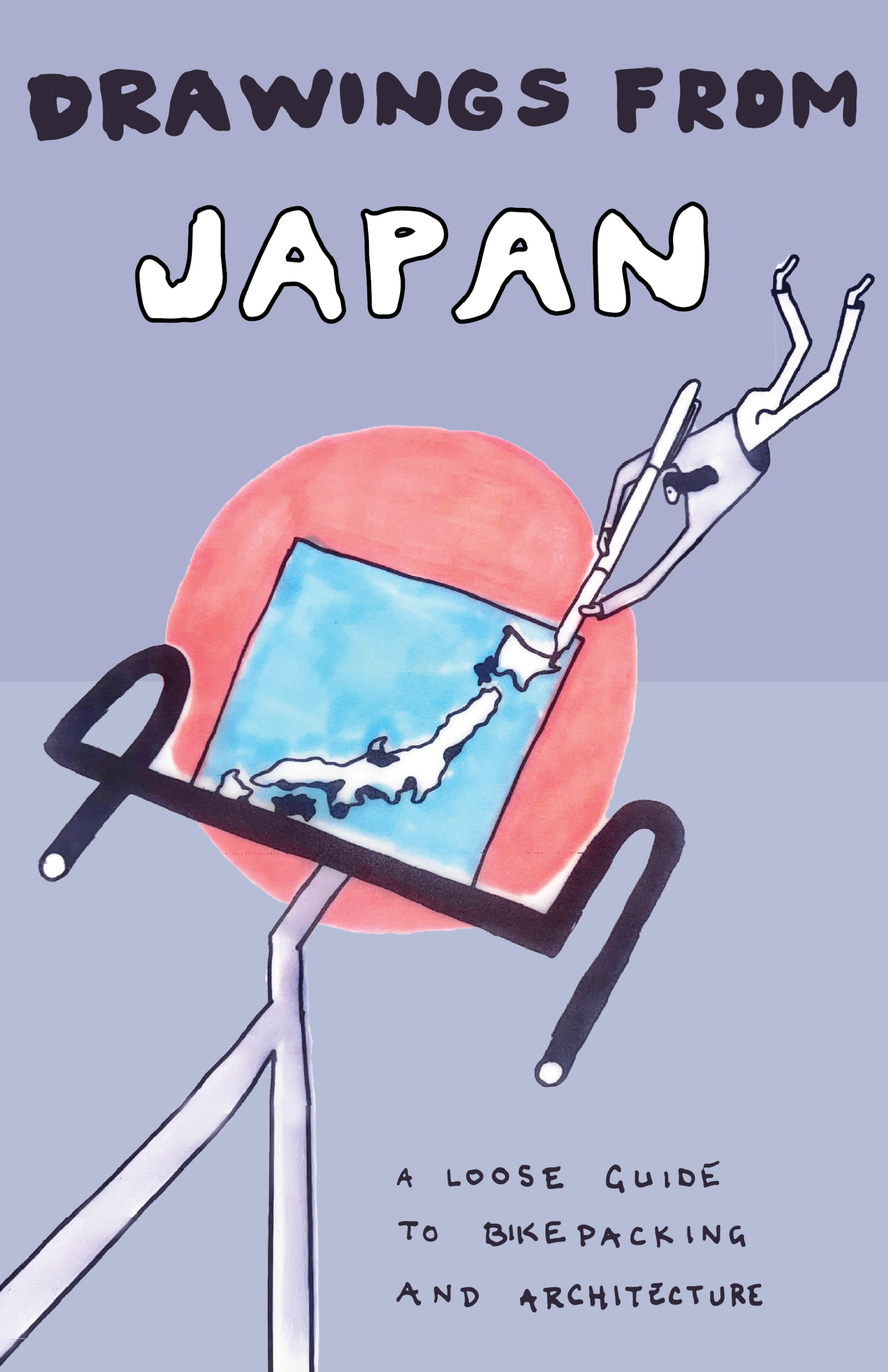

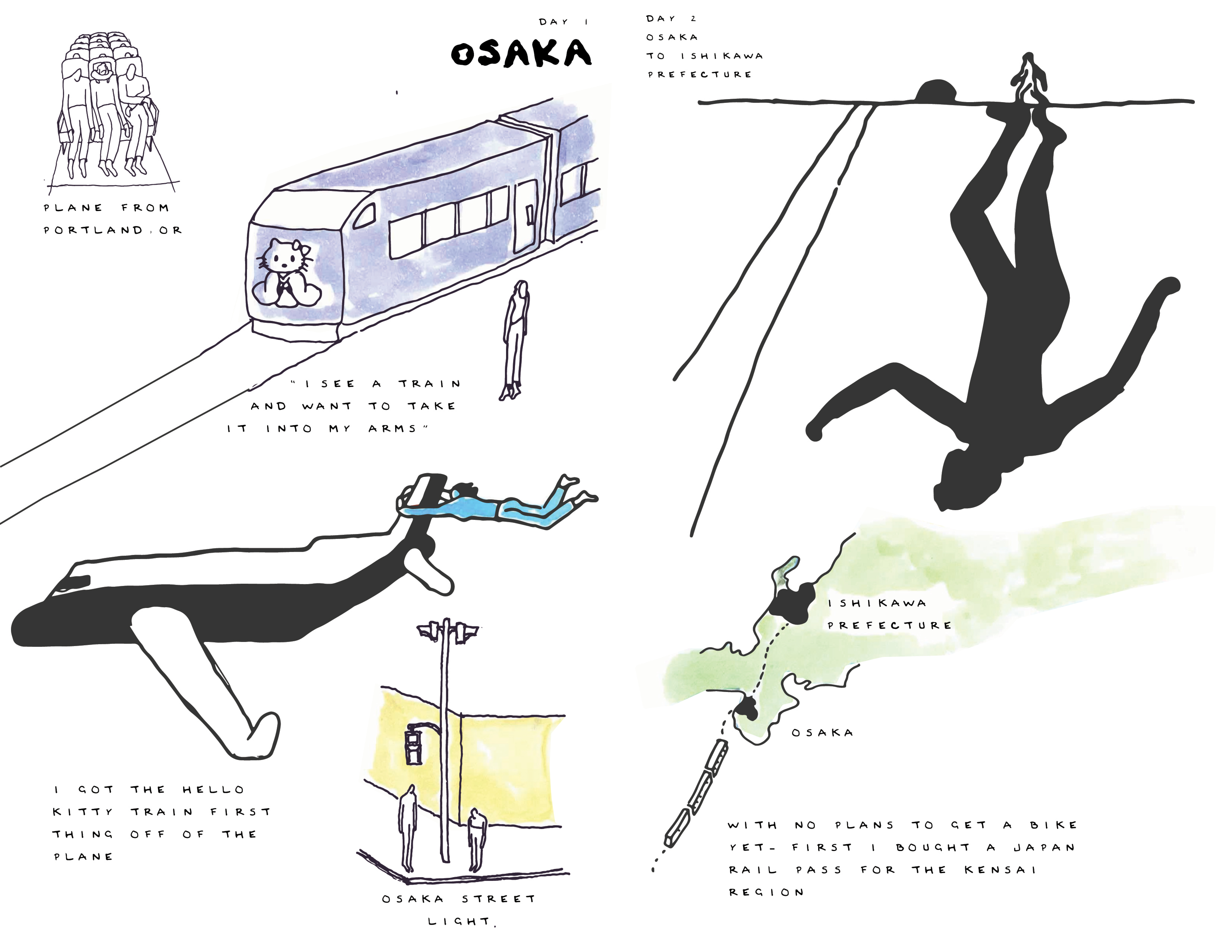
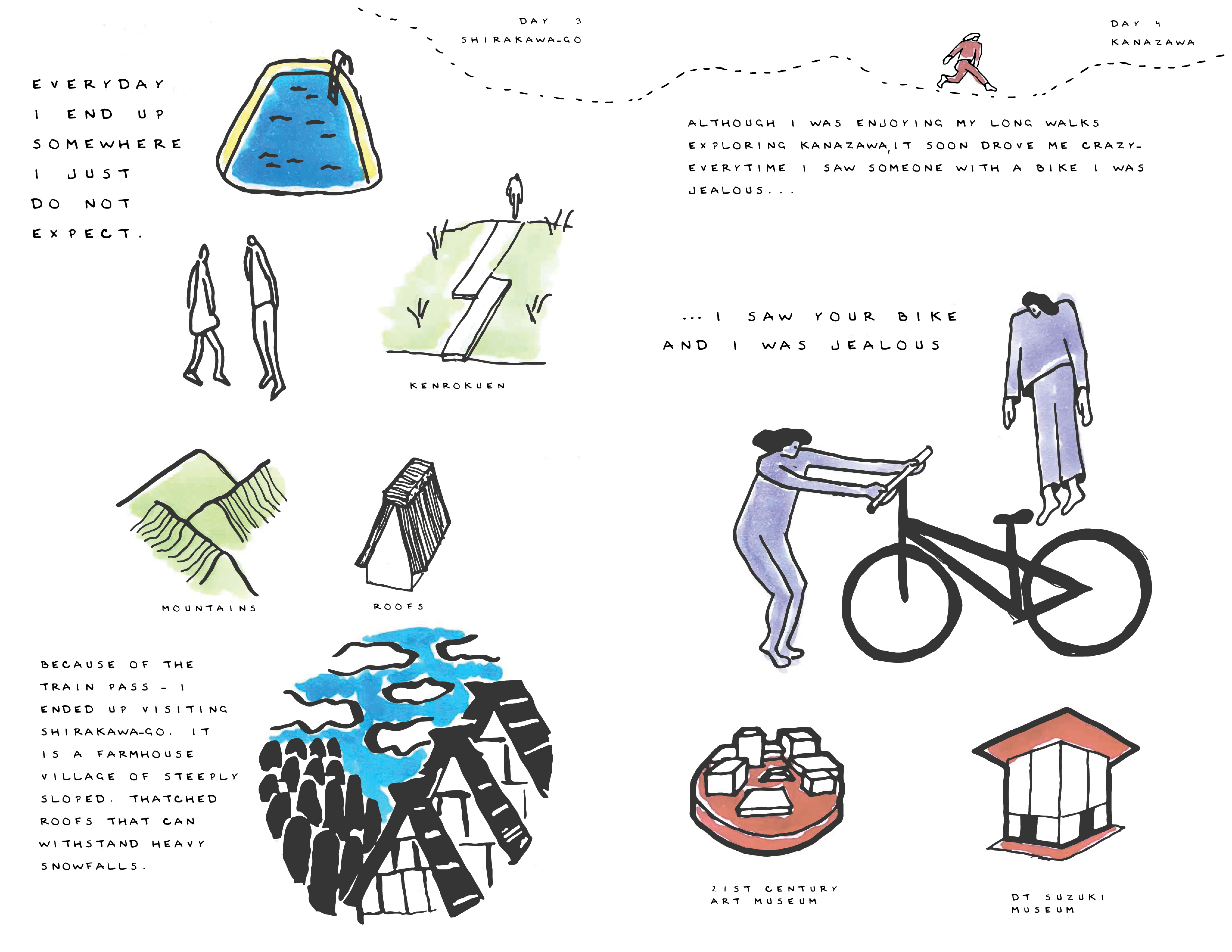

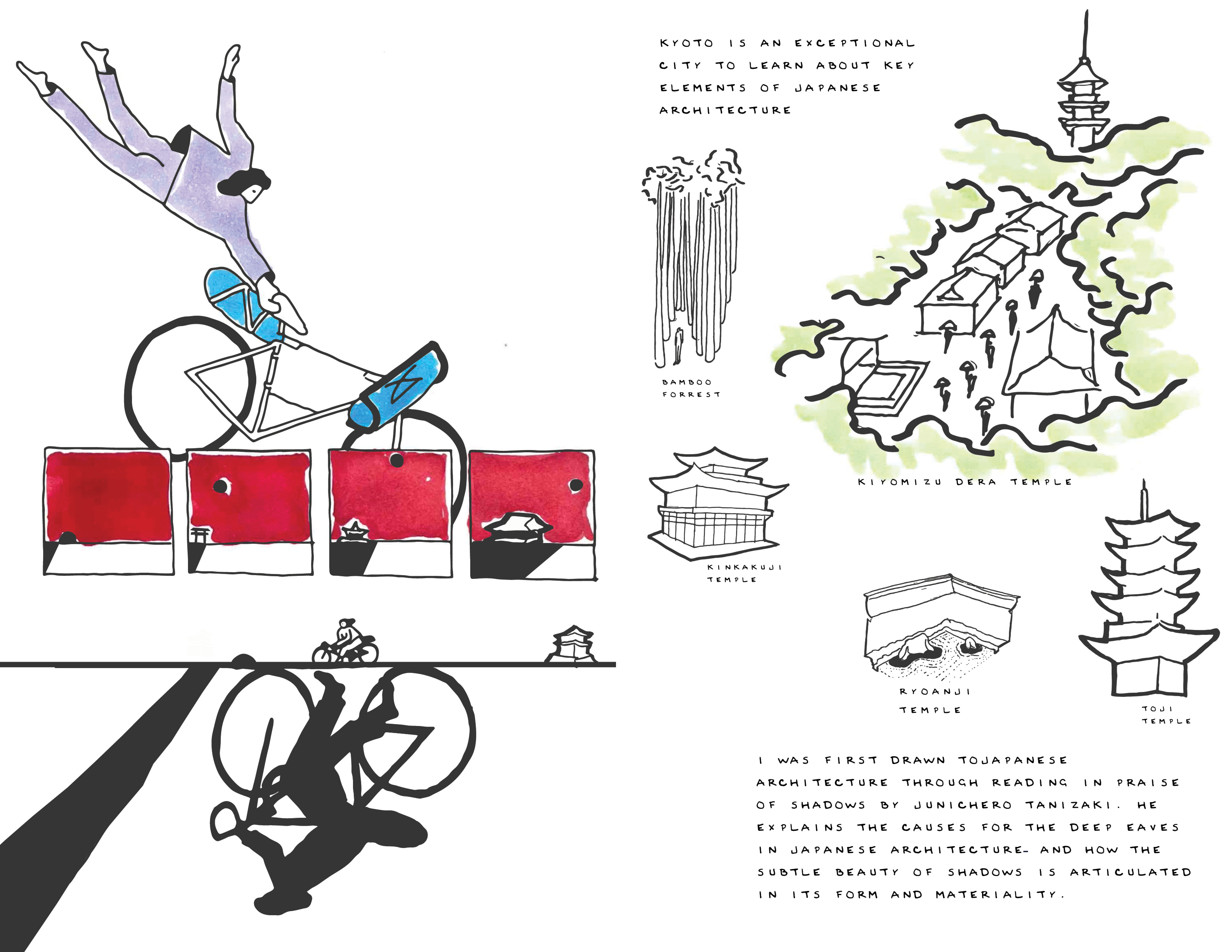
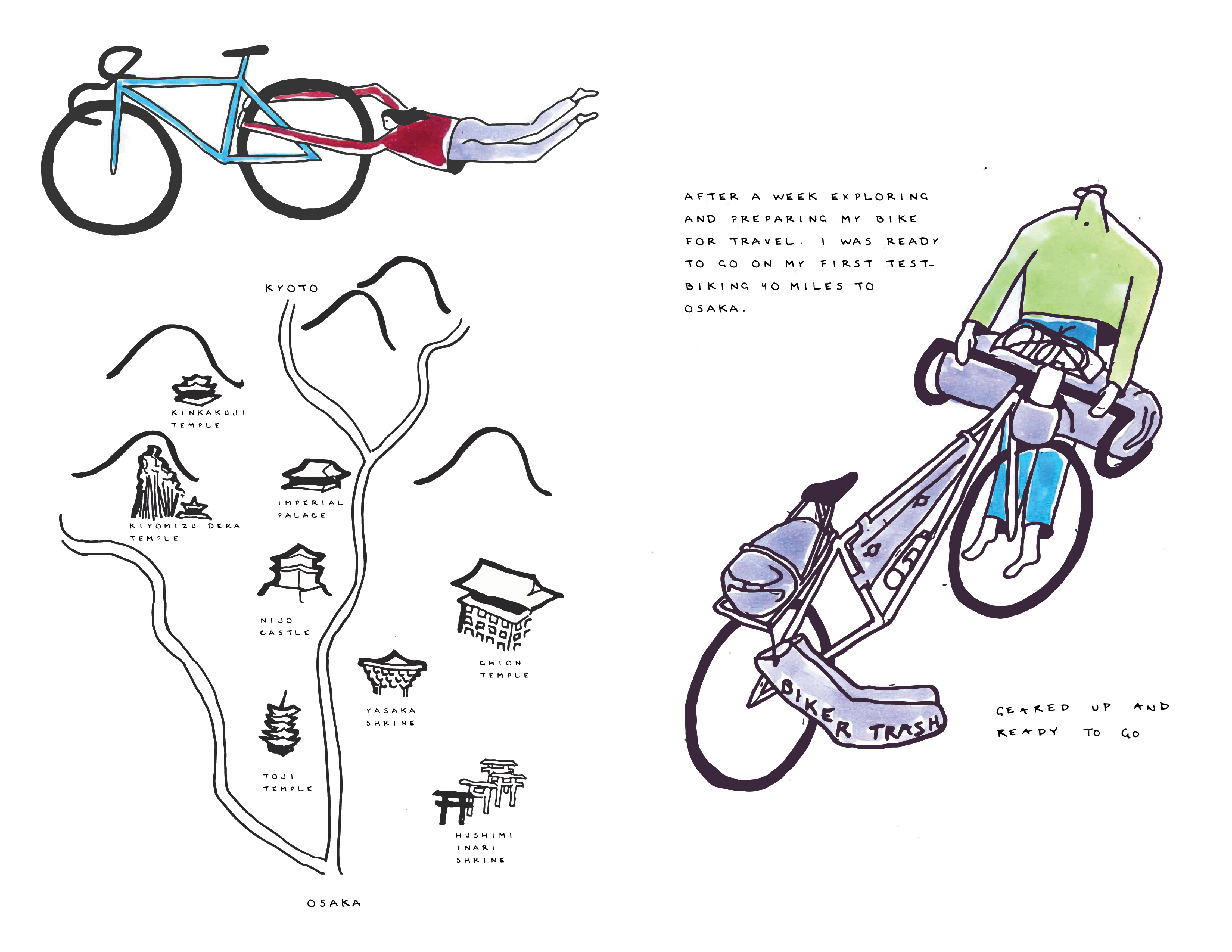
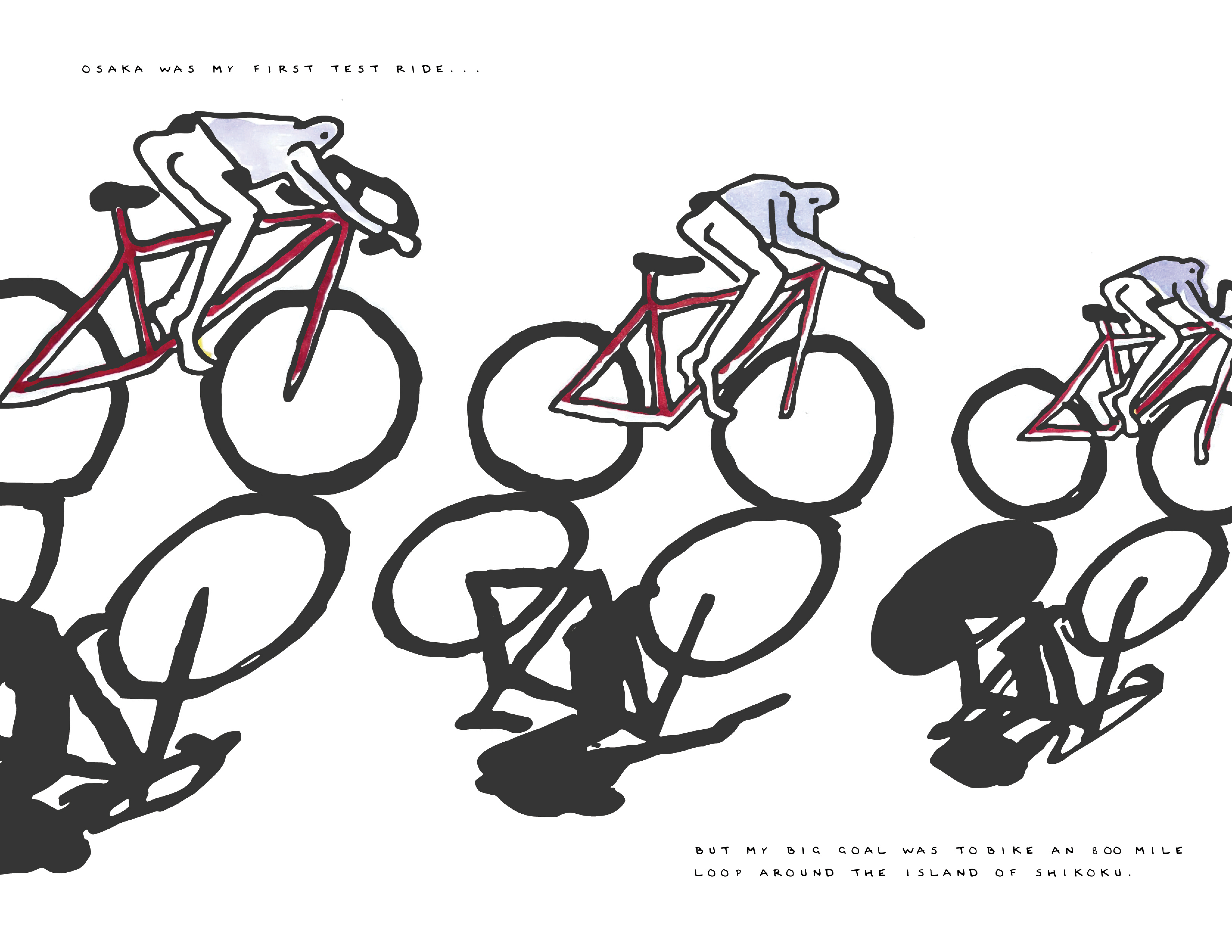
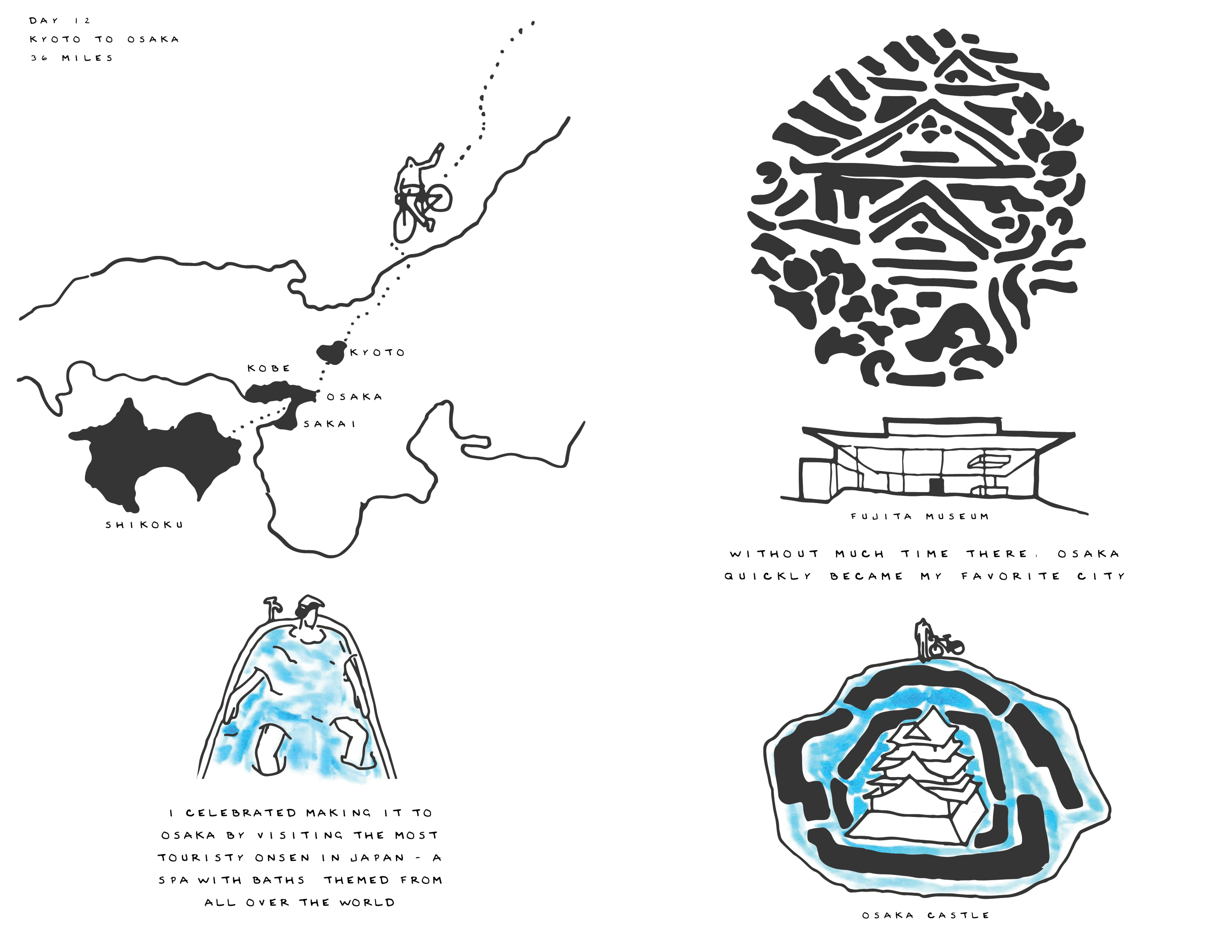


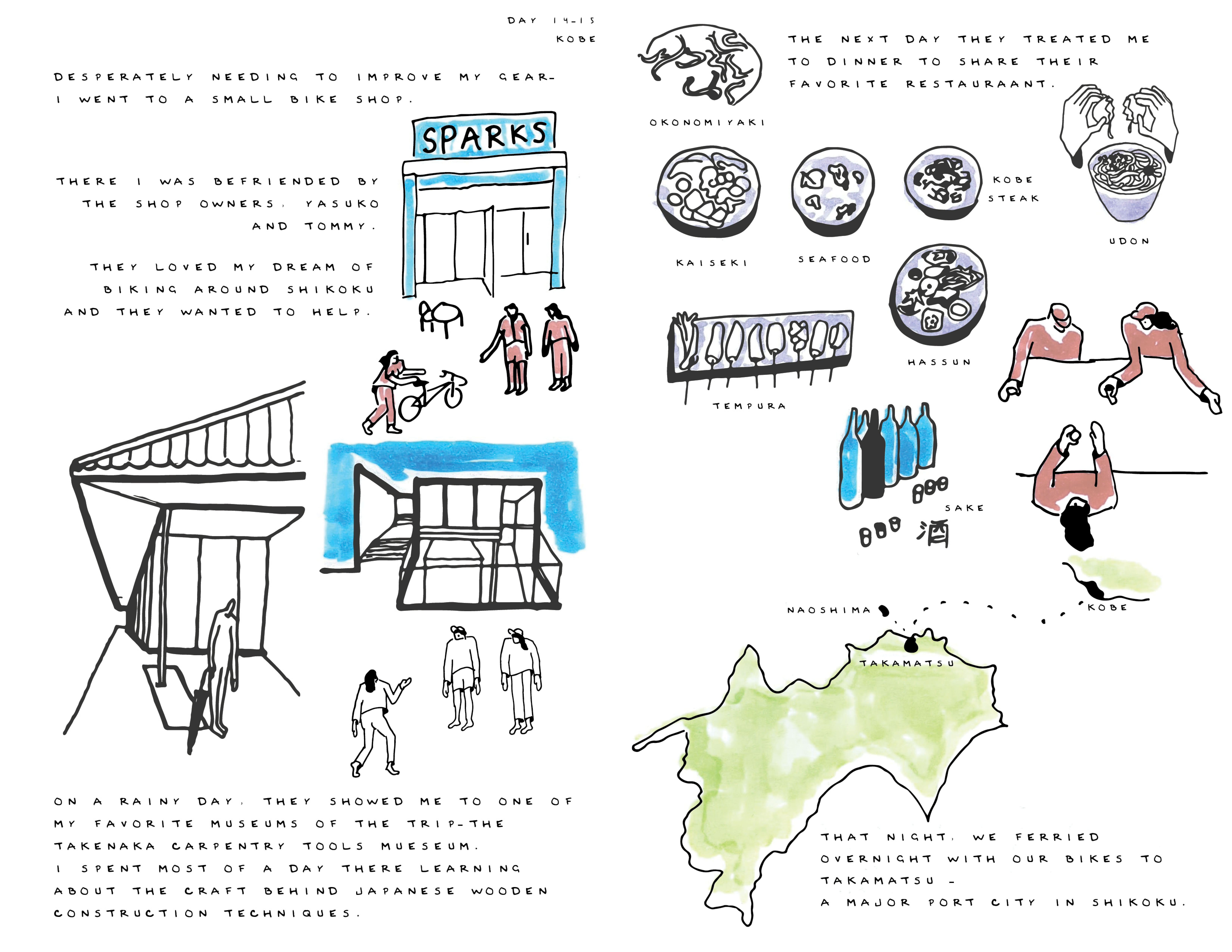
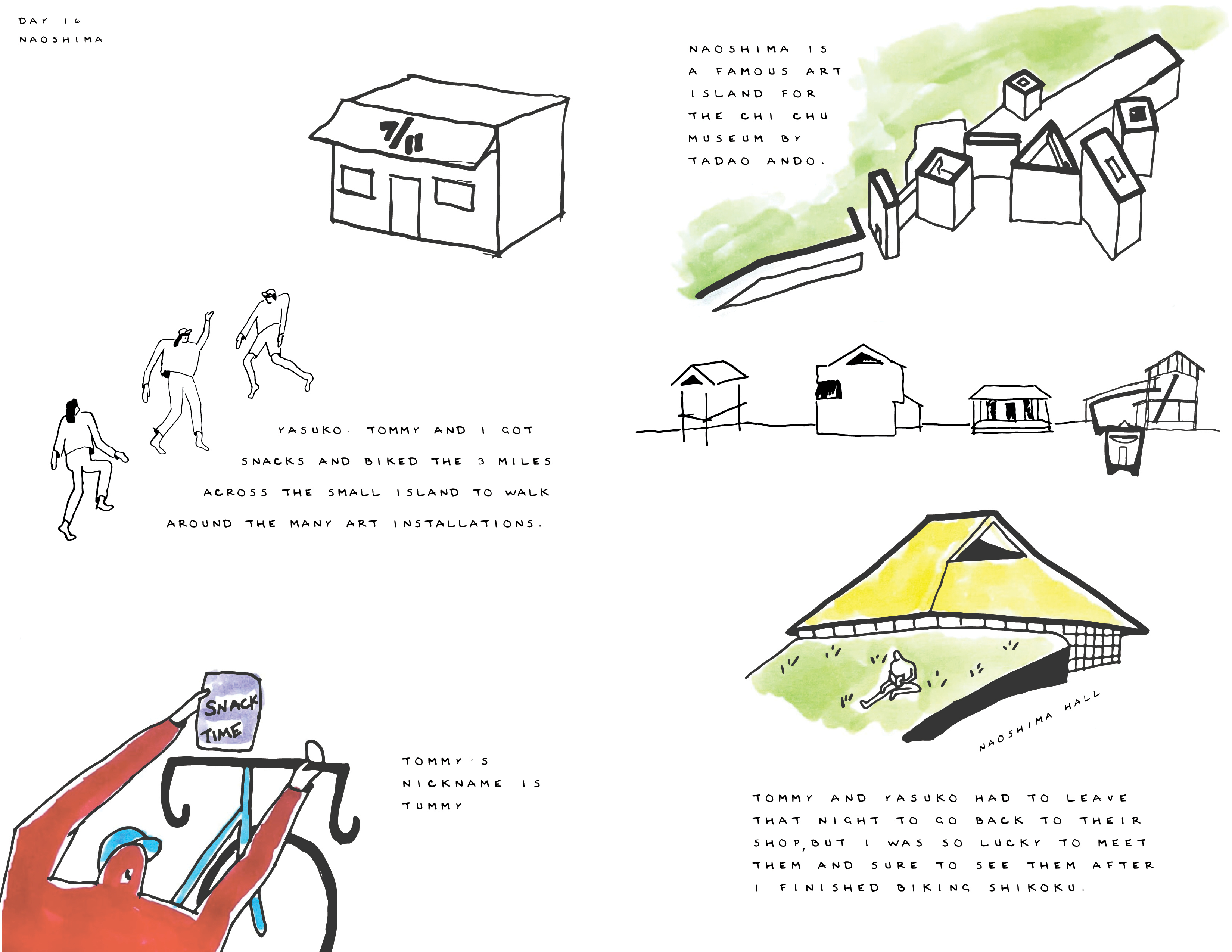
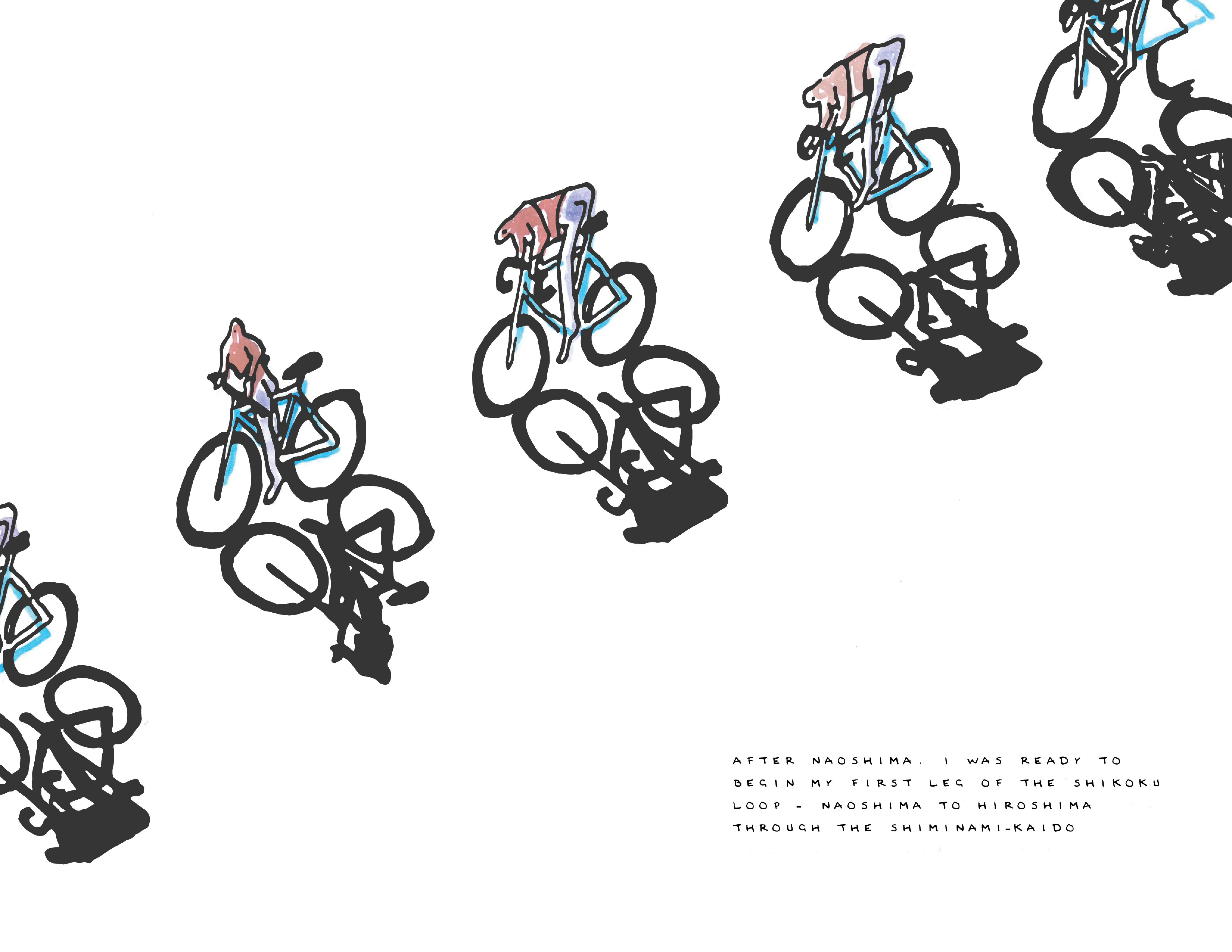


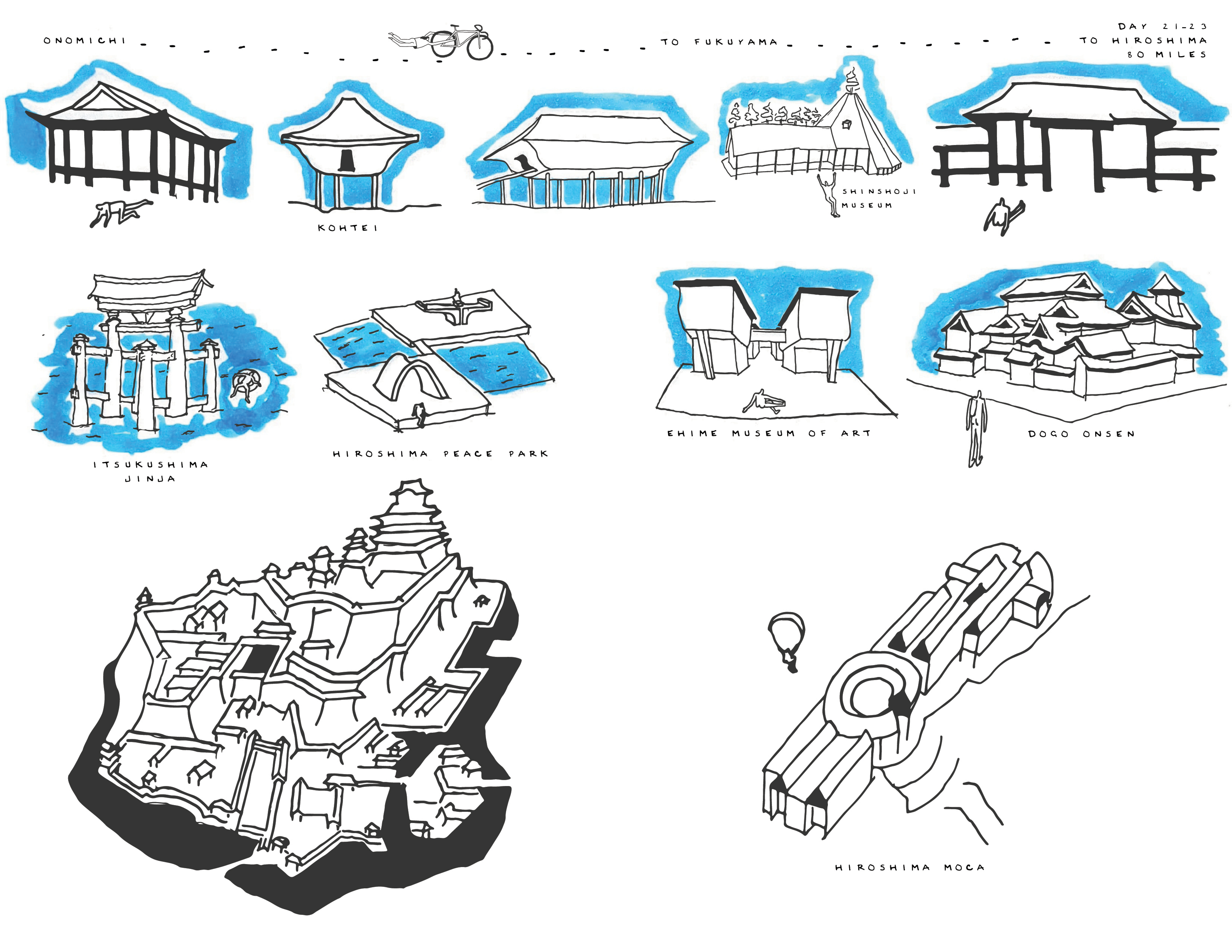
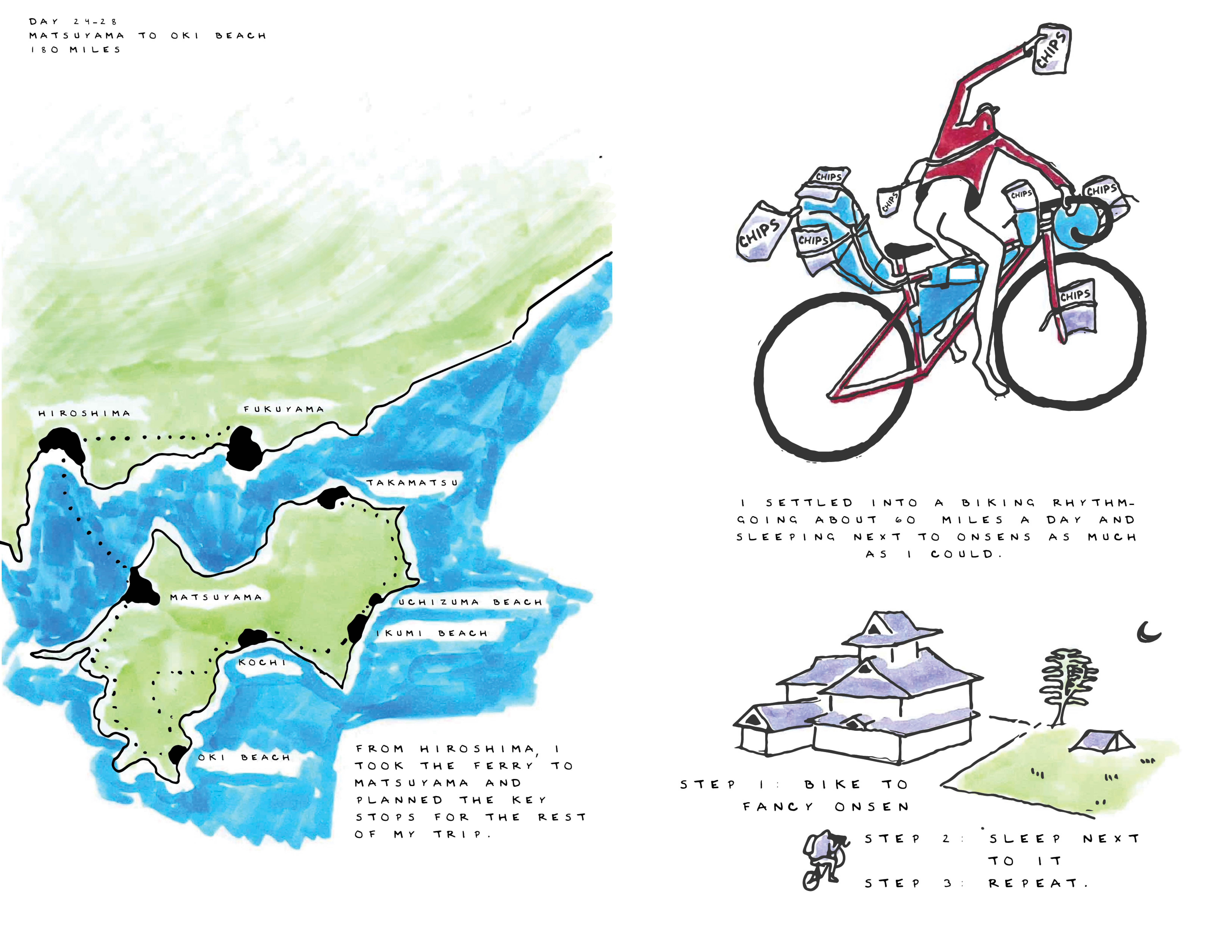

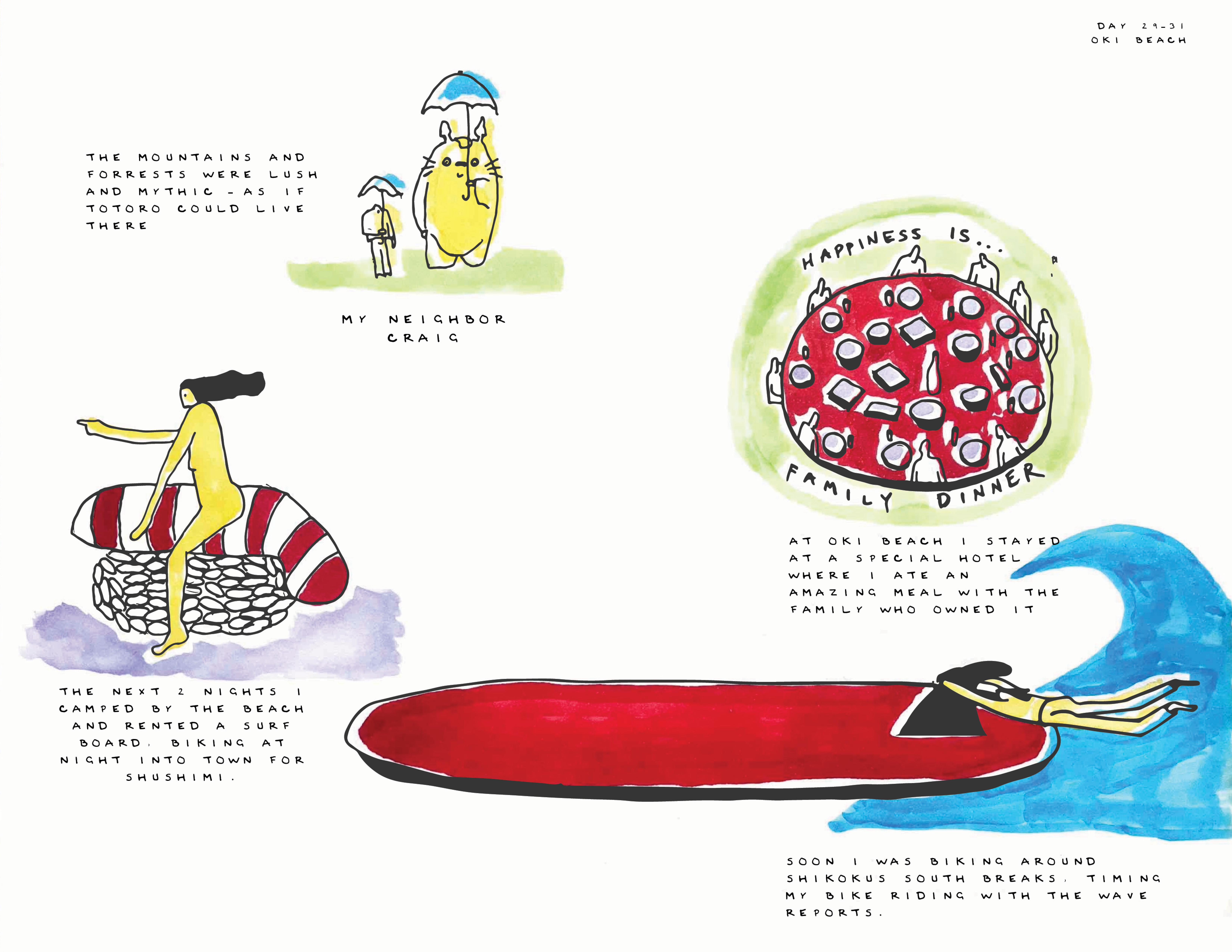



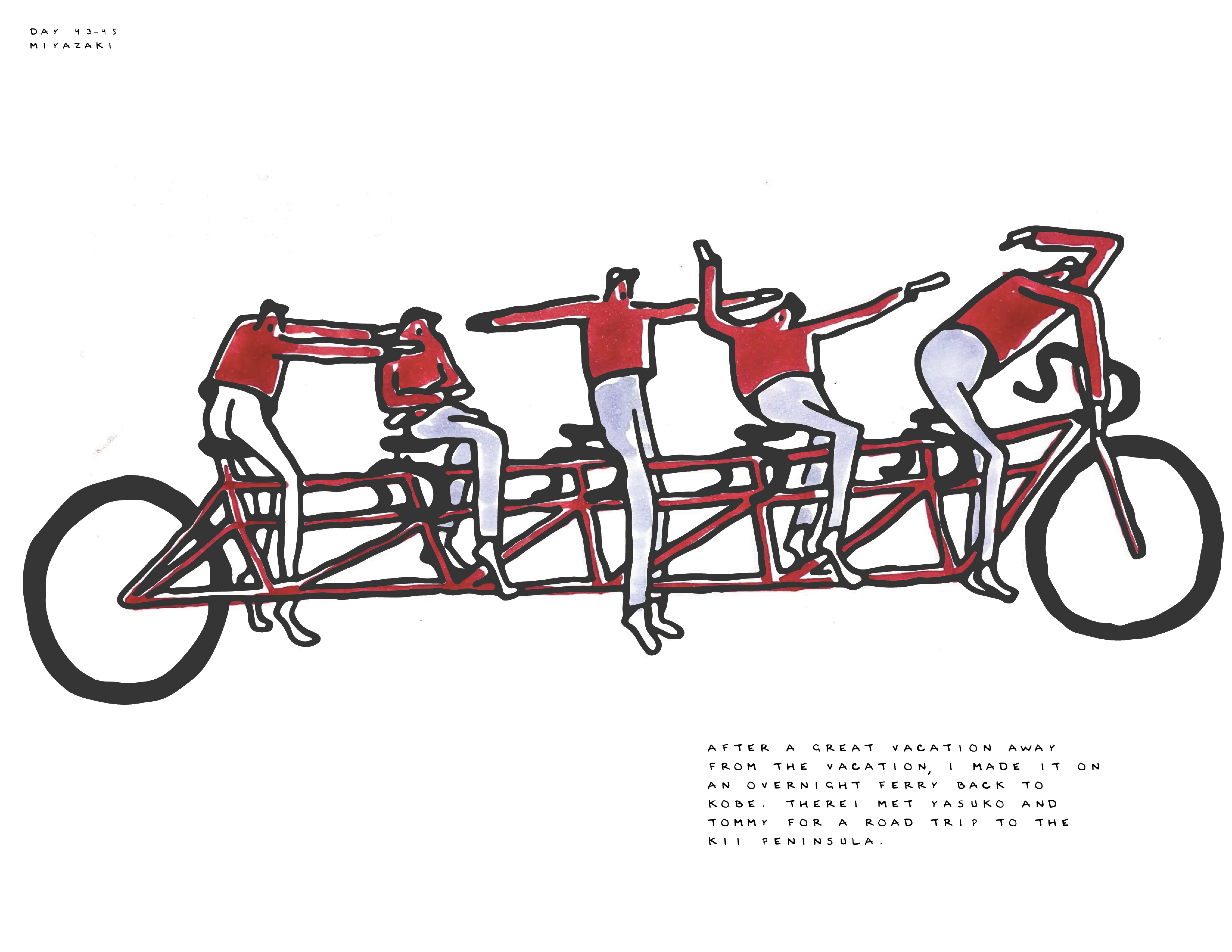
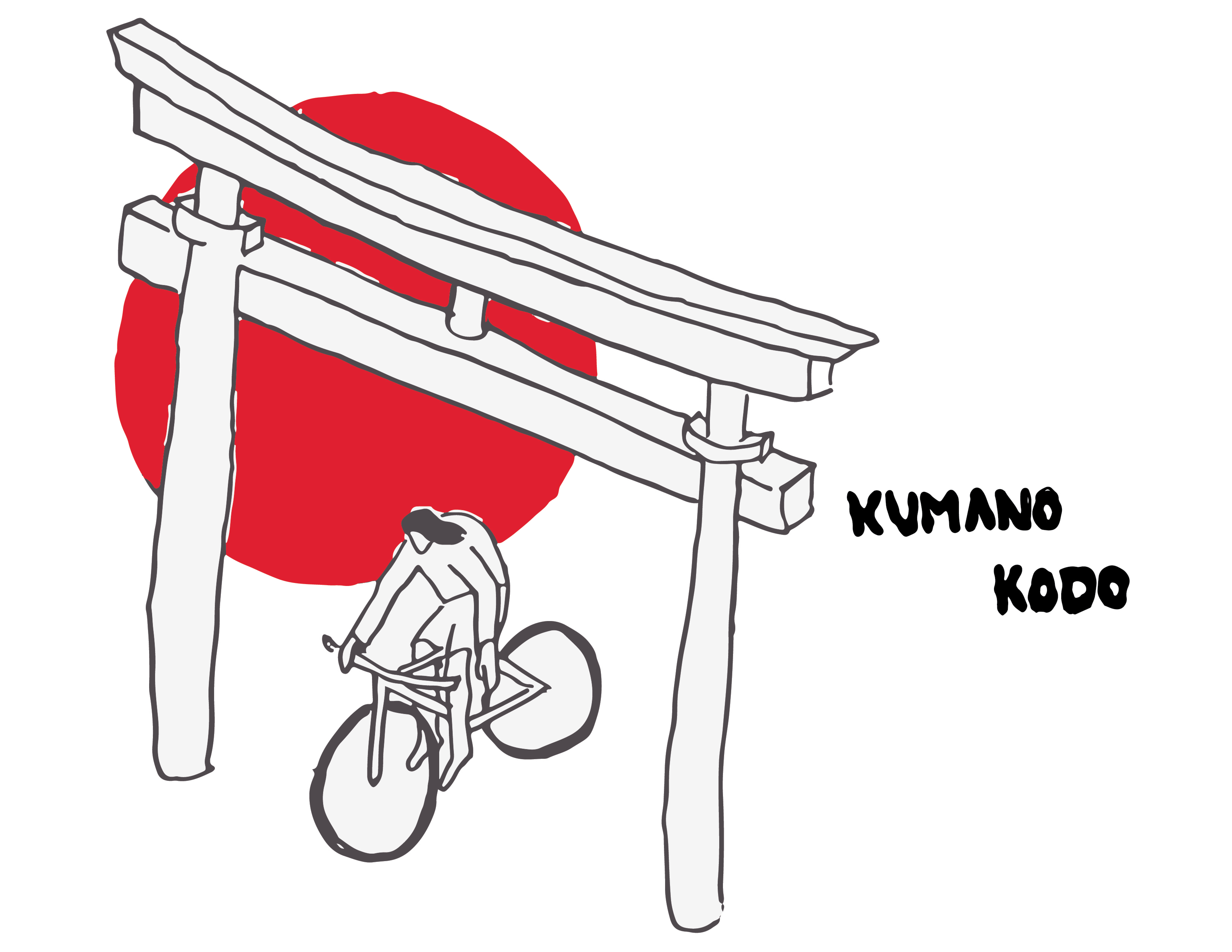
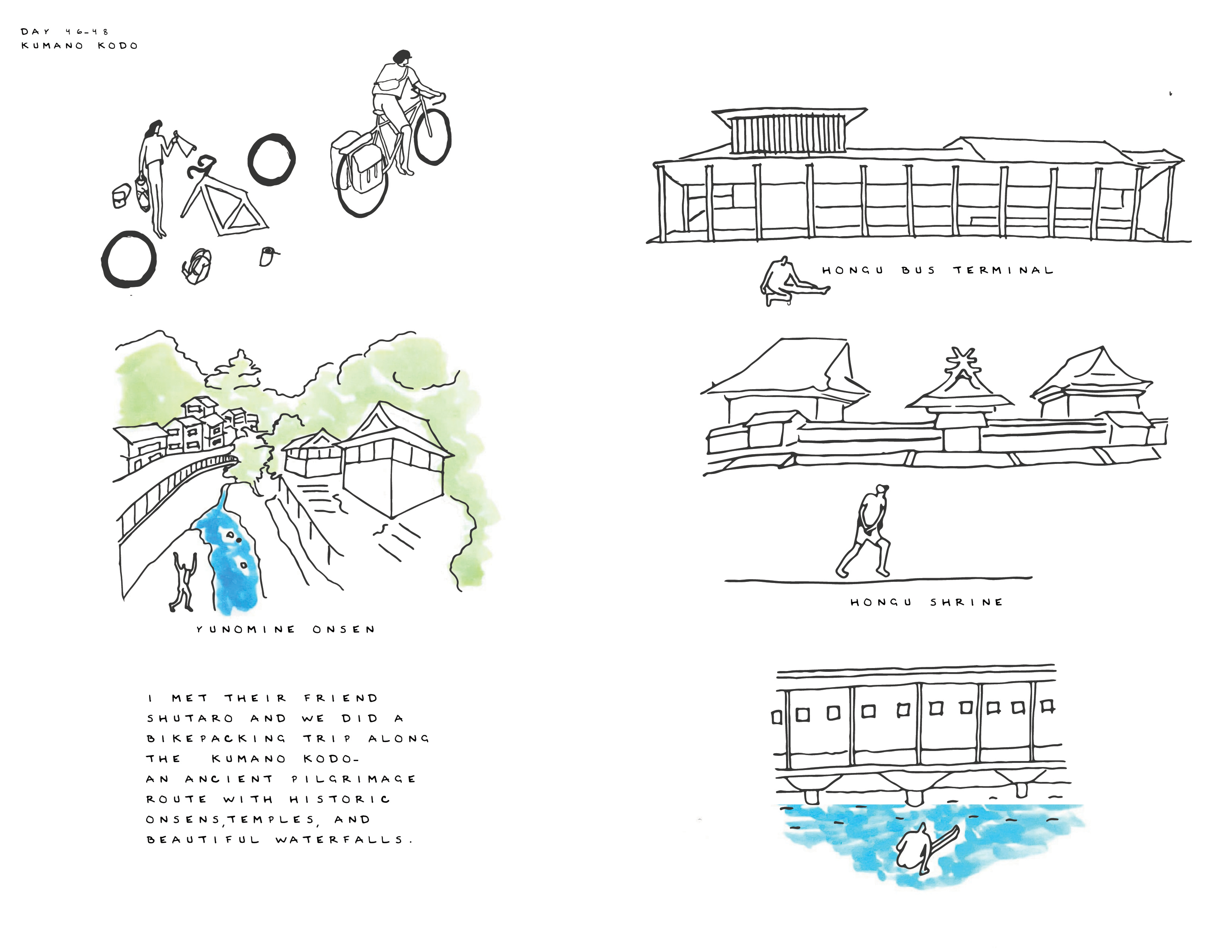


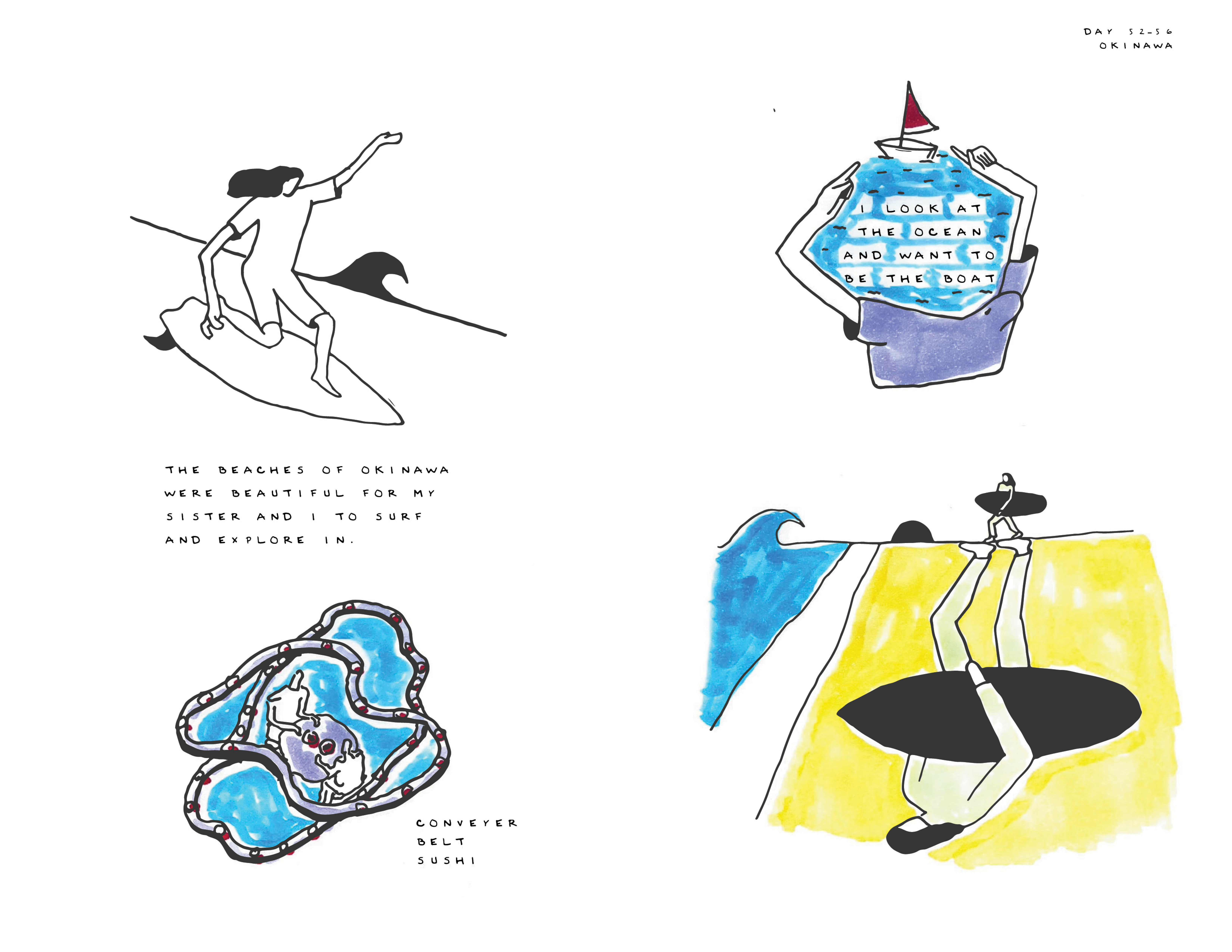
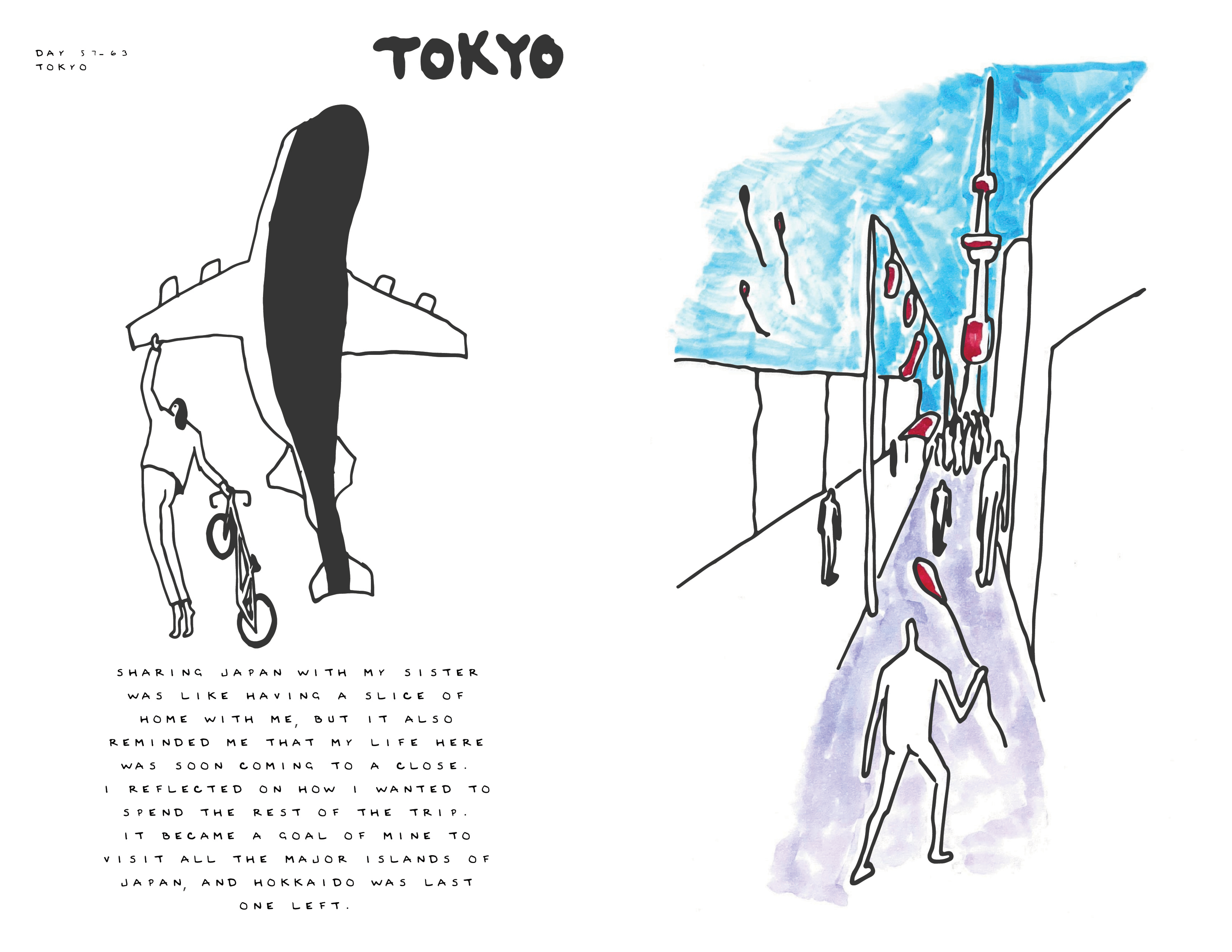

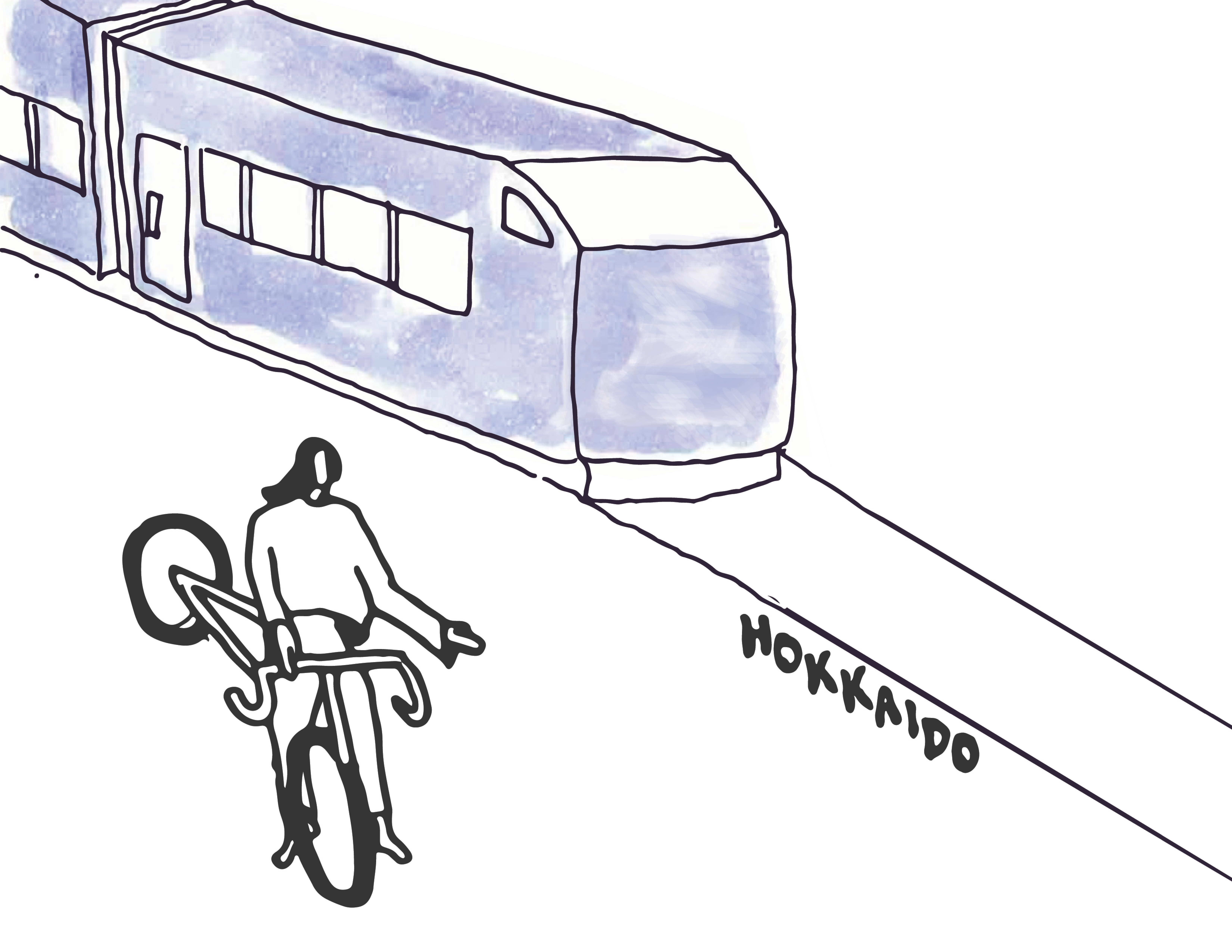


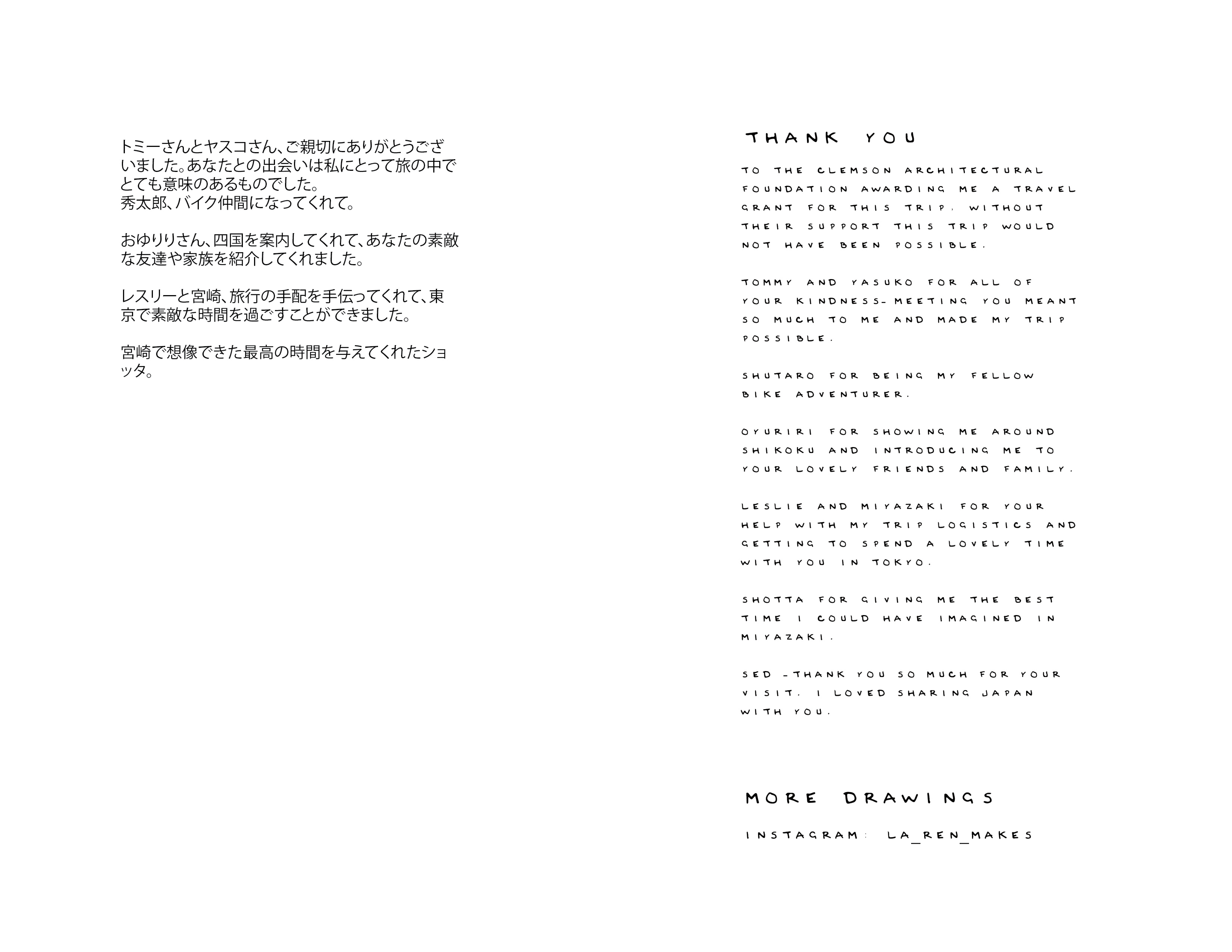

DRAWINGS FROM JAPAN
Below is the winning essay from a 5,000 dollar travel grant competition and the accompinying zine I made from my travel drawings of the trip. The essay and proposed trip aims to study how architecture responds when it has to assimilate to technology from outside of its own context. It is inspired by the book In Praise of Shadows by Jun’ichero Tanizaki.
Drawings from Japan is a self-published zine developed further in my sequential art making course at the Rhode Island School of Design. The zine aims to inspire a kind of simplified travel made through limiting yourself to go everyday by how much you can pedal. The illustrations highlight my favorite buildings and architectural experiences there and how the bike pulled me into the environment of Japan and inspired me to befriend people, learn the culture, and gain a deep since of independence while I was there.
Duration: 2 months
Type: Self-Published
School: Awarded from Clemson University, Further Developed at Rhode Island School of Design
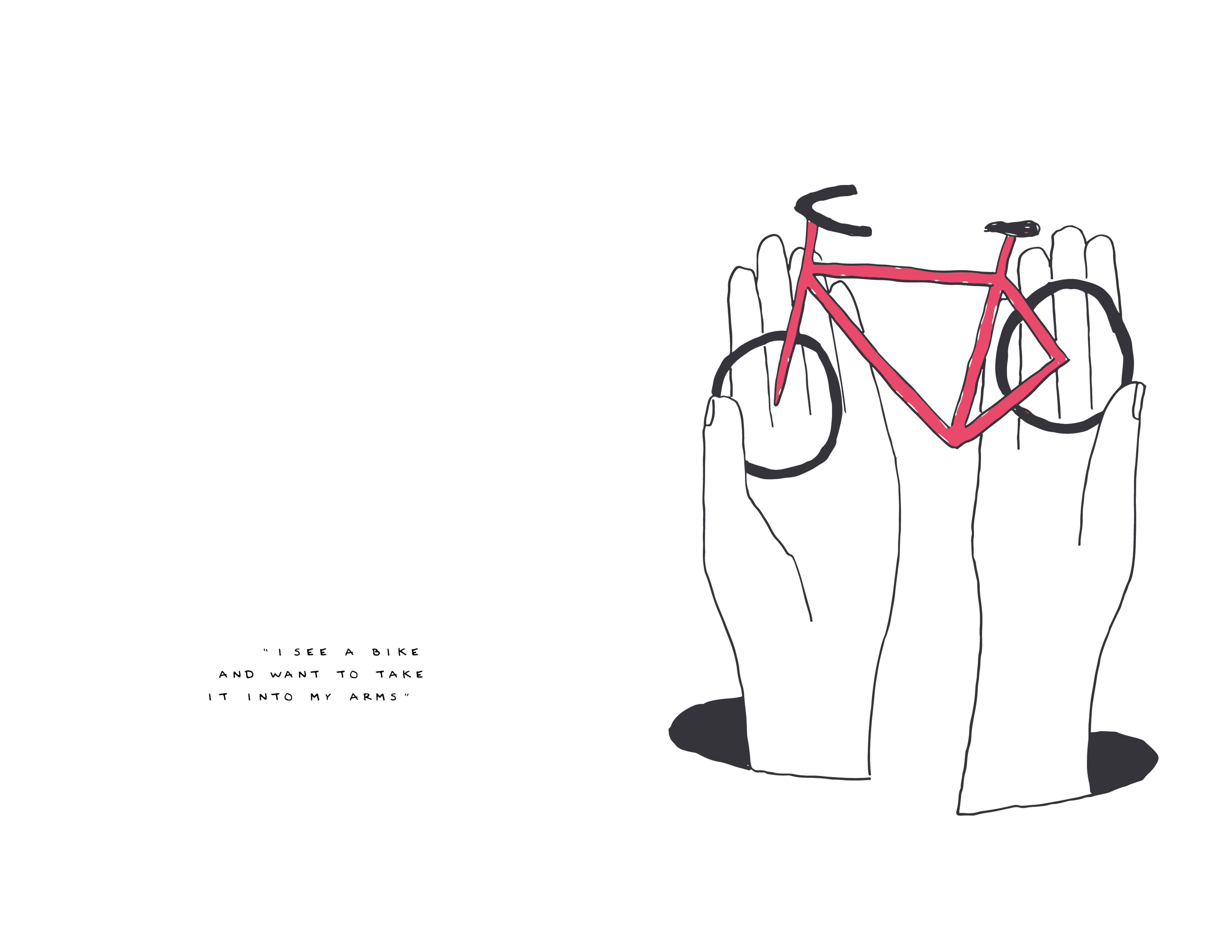







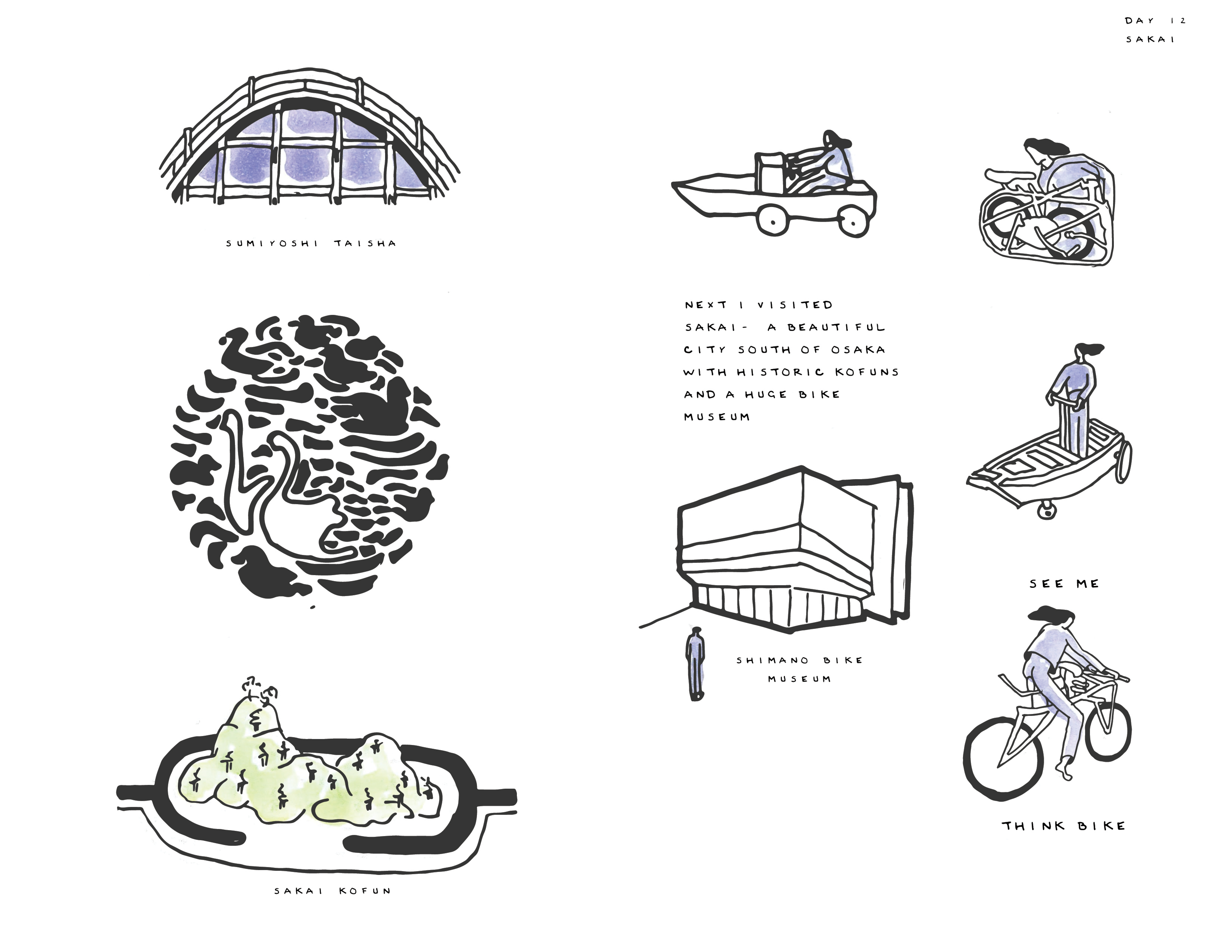











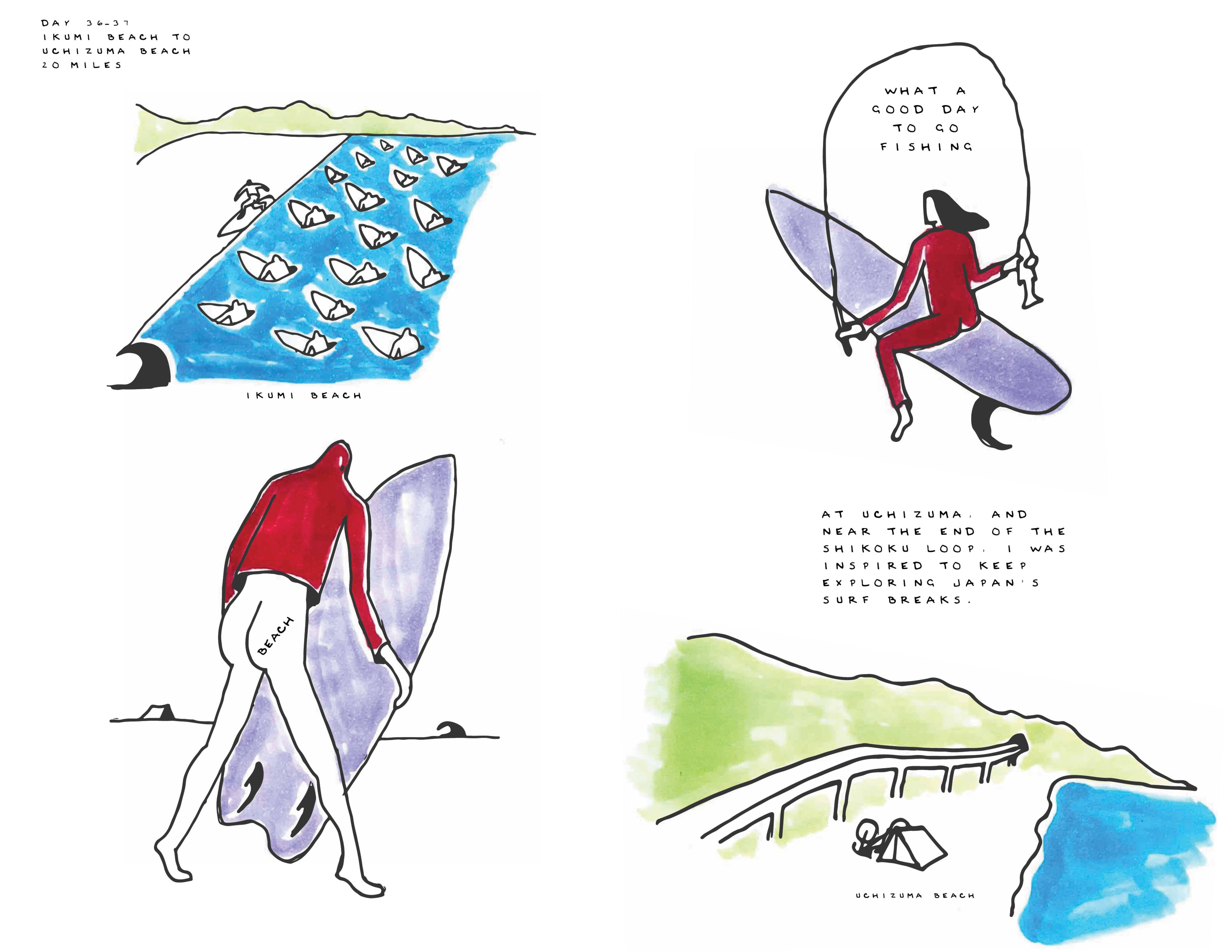










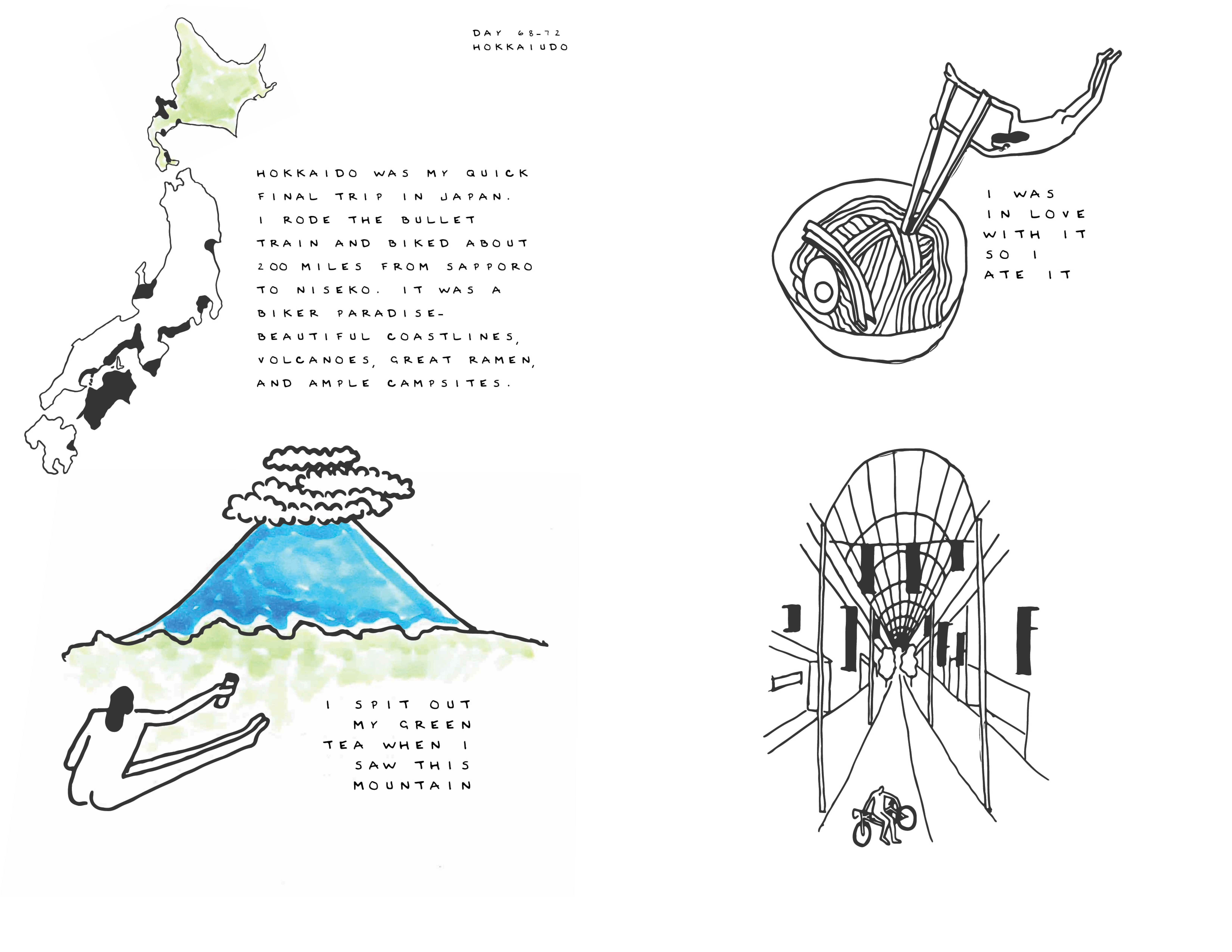
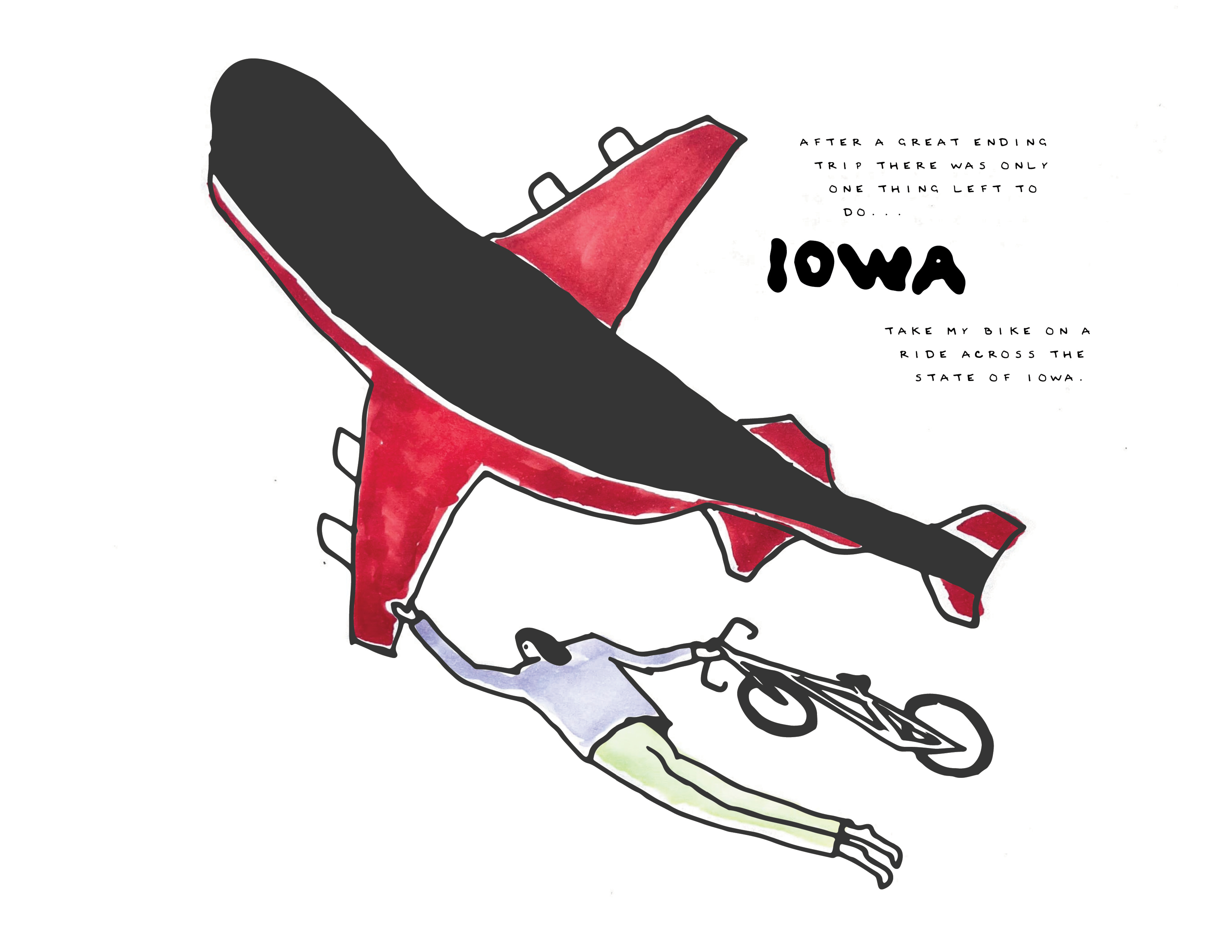
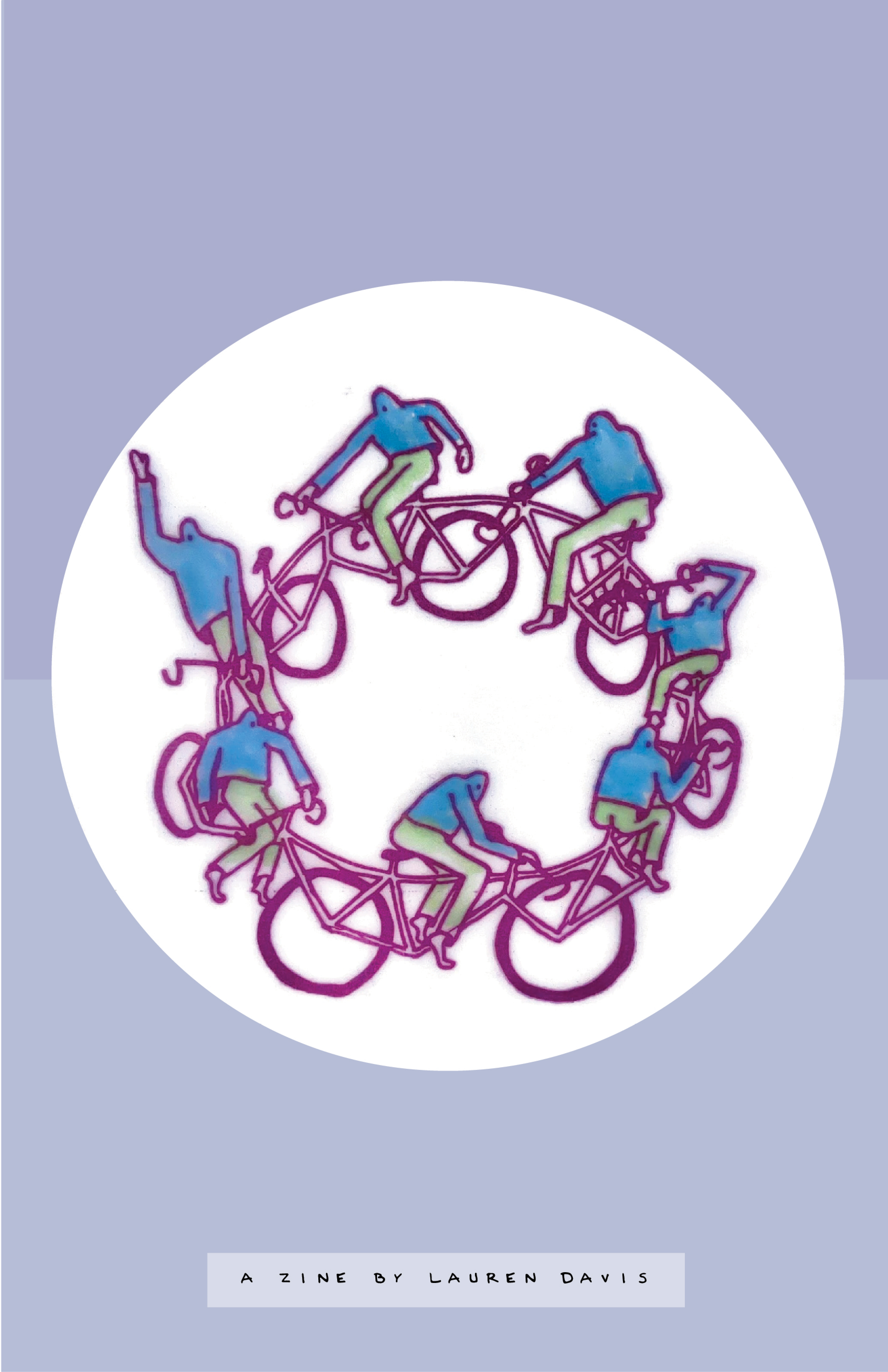

WINNING TRAVEL ESSAY AND PROPOSAL:
Tracing Lost Steps in an Architectural Lineage
I see the CAF Prize in Architecture as an opportunity to study what happens to architecture when it has to assimilate to technology from outside of its own context. I became interested in how innovation affects the built world through reading In Praise of Shadows by Jun’ichero Tanizaki. This book illustrated to me not only the beauty of traditional Japanese architecture but its key philosophical and formal differences from western architecture. Tanizaki outlines this beauty in the cultivation of rich shadows in Japanese architecture. For example, to quote Tanizaki, “in the gothic cathedral of the west, the roof is thrust up and up so as to place its pinnacle as high in the heavens as possible- and that herein is thought to lie in its special beauty. In the temples of Japan, on the other hand, a roof of heavy tiles is first laid out, and in the deep, spacious shadows created by the eaves the rest of the structure is built.”
Tanizaki further explains how as new technologies from the west become a necessity to modern life, Japan had to adapt to take on western styles of architecture. In this process, its inherent beauty becomes lost. I want to understand the importance of what becomes lost in an architectural lineage when architecture cannot move forward in ordered steps. First I would like to gain an understanding of Japanese architecture’s beauty through visiting the towns mentioned in Shadows as having some of the richest traditional architecture in Japan. Then I want to trace what is left of its past legacy through visiting Tokyo, the most westernized city in Japan. I would like to apply my interest and experience in photography to the environments I discover as a tool to aid my understanding of the qualities of light present and how they are shaped by their cultural context. Through photographing the traditional architecture alongside the appropriated forms I find; I will evidence what is lost when architecture is outfitted for technology, as well as evidence possible solutions for the future.
Too often, innovation is seen as a necessity. The advantages of a previous technology, a previous way of life, become forgotten in its wake. Furthermore, the affect on architecture when it has to assimilate to technology from outside of its own context is an underappreciated aspect of innovation and cultural identity. As the world is developing at rates never seen before, and cities are transformed by climate change, this affect will only become more relevant. If an architect is looking to create complete environments, it is necessary to honor the history of that environment. With this sensibility, one can understand what becomes lost in an architectural lineage when it develops too rapidly. My trip is about developing an understanding of an architectural heritage that did not have the ability to move forward in its own way.
Japan was brought to my attention through In the Praise of Shadows, but the application of this research could be traced to any urban context. I can see its heritage in the many places I have studied architecture, including the foothills vernacular of Clemson, the legacy of the Charleston Single Home, the influences of the adobe pueblo in Paolo Soleri’s urban experiment of Arcosanti, and the periods of history layering the city of Barcelona. However, traveling to an eastern context, devoid of Roman foundations, will give me an entirely new heritage of architecture to decipher. I think this is vital for me moving forward in career aspirations as I am really interested in pursuing innovative but community driven architecture through a design build lens. What brought me towards this “lens” was through working on the Enston Home Farm Stand through the Charleston Community build studio. There I learned the importance of rooting innovative architecture in the context of a historical and architecturally significant neighborhood, the Enston Homes. Our farm stand appealed to the residents of the neighborhood by translating important historical patterns through a modern lens. It was my interest from the beginning to study these patterns and implement their technology into our resulting building. These patterns included a gateway that acts as a signifier to a community, arches that signify the entrance of a building, a clearstory to bring in light, and a pitched roof to withstand heavy rainfall. Had we not done extensive research these important patterns, we would have not been able to understand how to innovate from their technology. The resulting building provides a modern approach while still forming to is context that the neighborhood can appreciate and love for its beauty.
Finding these patterns and implementing them into a building was so gratifying that I cannot imagine designing quality spaces without this skill. Through the CAF trip, I want to continue developing this skill so that I can continue to apply it to architectural projects of the future.
Date won: Spring 2020
I see the CAF Prize in Architecture as an opportunity to study what happens to architecture when it has to assimilate to technology from outside of its own context. I became interested in how innovation affects the built world through reading In Praise of Shadows by Jun’ichero Tanizaki. This book illustrated to me not only the beauty of traditional Japanese architecture but its key philosophical and formal differences from western architecture. Tanizaki outlines this beauty in the cultivation of rich shadows in Japanese architecture. For example, to quote Tanizaki, “in the gothic cathedral of the west, the roof is thrust up and up so as to place its pinnacle as high in the heavens as possible- and that herein is thought to lie in its special beauty. In the temples of Japan, on the other hand, a roof of heavy tiles is first laid out, and in the deep, spacious shadows created by the eaves the rest of the structure is built.”
Tanizaki further explains how as new technologies from the west become a necessity to modern life, Japan had to adapt to take on western styles of architecture. In this process, its inherent beauty becomes lost. I want to understand the importance of what becomes lost in an architectural lineage when architecture cannot move forward in ordered steps. First I would like to gain an understanding of Japanese architecture’s beauty through visiting the towns mentioned in Shadows as having some of the richest traditional architecture in Japan. Then I want to trace what is left of its past legacy through visiting Tokyo, the most westernized city in Japan. I would like to apply my interest and experience in photography to the environments I discover as a tool to aid my understanding of the qualities of light present and how they are shaped by their cultural context. Through photographing the traditional architecture alongside the appropriated forms I find; I will evidence what is lost when architecture is outfitted for technology, as well as evidence possible solutions for the future.
Too often, innovation is seen as a necessity. The advantages of a previous technology, a previous way of life, become forgotten in its wake. Furthermore, the affect on architecture when it has to assimilate to technology from outside of its own context is an underappreciated aspect of innovation and cultural identity. As the world is developing at rates never seen before, and cities are transformed by climate change, this affect will only become more relevant. If an architect is looking to create complete environments, it is necessary to honor the history of that environment. With this sensibility, one can understand what becomes lost in an architectural lineage when it develops too rapidly. My trip is about developing an understanding of an architectural heritage that did not have the ability to move forward in its own way.
Japan was brought to my attention through In the Praise of Shadows, but the application of this research could be traced to any urban context. I can see its heritage in the many places I have studied architecture, including the foothills vernacular of Clemson, the legacy of the Charleston Single Home, the influences of the adobe pueblo in Paolo Soleri’s urban experiment of Arcosanti, and the periods of history layering the city of Barcelona. However, traveling to an eastern context, devoid of Roman foundations, will give me an entirely new heritage of architecture to decipher. I think this is vital for me moving forward in career aspirations as I am really interested in pursuing innovative but community driven architecture through a design build lens. What brought me towards this “lens” was through working on the Enston Home Farm Stand through the Charleston Community build studio. There I learned the importance of rooting innovative architecture in the context of a historical and architecturally significant neighborhood, the Enston Homes. Our farm stand appealed to the residents of the neighborhood by translating important historical patterns through a modern lens. It was my interest from the beginning to study these patterns and implement their technology into our resulting building. These patterns included a gateway that acts as a signifier to a community, arches that signify the entrance of a building, a clearstory to bring in light, and a pitched roof to withstand heavy rainfall. Had we not done extensive research these important patterns, we would have not been able to understand how to innovate from their technology. The resulting building provides a modern approach while still forming to is context that the neighborhood can appreciate and love for its beauty.
Finding these patterns and implementing them into a building was so gratifying that I cannot imagine designing quality spaces without this skill. Through the CAF trip, I want to continue developing this skill so that I can continue to apply it to architectural projects of the future.

